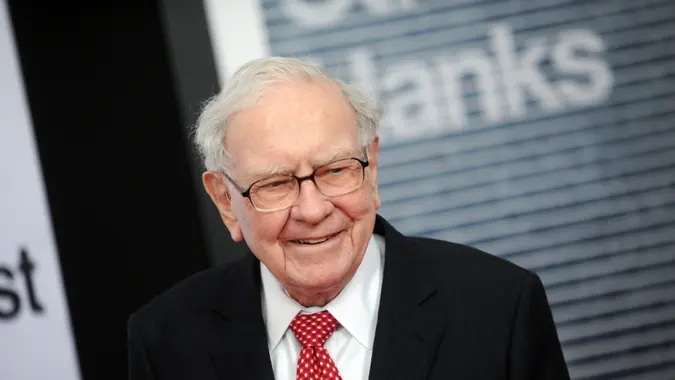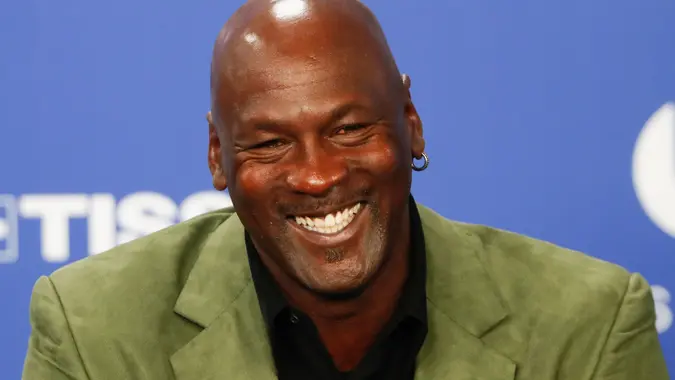I Asked a Wealth Manager How To Turn $1K Into $100K: Here’s the Plan

Commitment to Our Readers
GOBankingRates' editorial team is committed to bringing you unbiased reviews and information. We use data-driven methodologies to evaluate financial products and services - our reviews and ratings are not influenced by advertisers. You can read more about our editorial guidelines and our products and services review methodology.

20 Years
Helping You Live Richer

Reviewed
by Experts

Trusted by
Millions of Readers
According to an analysis by JPMorganChase Institute, more Americans are transferring their money from checking and savings accounts into brokerage accounts, money market funds and CDs in search of higher returns. With total cash reserves rising since mid-2024 and returning to historical growth trends, it’s evident that Americans are seeking ways to grow their funds as inflation remains a concern. If you’re just starting your investing journey, you can turn a modest amount of money into substantial savings with the power of compound interest and the passage of time working in your favor.
GOBankingRates spoke with wealth managers to determine strategies for how someone in their 20s with a long-time horizon can turn $1,000 into $100,000 — below is what they said.
How Long Would It Take To Turn $1,000 Into $100,000?
If you were to put $1,000 into the stock market and invest in an index fund, how long would it take to have this figure reach $100,000?
Investing in the S&P 500 or an Index Fund
“It’s highly unlikely that an index fund could turn $1,000 into $100,000 before they retire,” said Asher Rogovy, chief investment officer of Magnifina. “Historically, U.S. stock indices have returned approximately 10%. If $1,000 compounds at 10% per year, it will be just under $73,000 in 45 years.”
It’s worth pointing out that if you start working at 20 and plan on retiring at 65, that’s 45 years, meaning that you wouldn’t reach six figures with the initial investment in an index fund that tracks the S&P 500. These figures also don’t factor in inflation, which could erode the real returns.
Alan Locke, certified financial planner (CFP) and the president of Locke Investment Management, also pointed out that the stock market has a general return of 10% annually when sharing his calculations. Locke is a proponent of the Rule of 72, where you divide 72 by the interest rate and this will tell you the number of years it would take for your investment to double.
“Divide 72 by the stock market’s long-term average (say 10%) and this will give you 7.2 years. At that rate, it would take 47 years for $1,000 to turn into $100,000 (excluding taxes),” Locke said.
If you invest in a general index fund or fund that tracks the S&P 500, then it would take you 47 years to have your initial $1,000 investment turn into $100,000. This assumes that you don’t add any additional funds to your brokerage account.
Investing in Individual Stocks
“To achieve 15% to 25% returns, smart investors take concentrated positions in a handful of individual stocks,” Rogovy said. “Let me be clear, this approach can bring significantly more risk. Fortunately, there are plenty of investment advisors who engage in active investment management and performance-focused investing strategies.” To accelerate the process of growing your savings, consider investing in individual stocks.
Locke also noted that more aggressive investing could provide a return of 15% annually and this would turn $1,000 into $100,000 in about 32 years. While it’s challenging to determine which specific stock would provide returns of 15% or higher, you could start by looking at past performance or hiring a financial advisor who can make a tailored plan for your situation.
How You Can Turn $1,000 Into $100,000 Considerations
If you’re looking for how you can turn your initial $1,000 investment into $100,000, there are a few considerations that you can’t ignore.
You’ll Have To Take Some Risks for Quicker Growth
Rogovy brought up that building substantial wealth before retiring requires a more aggressive investment plan and he stressed that most companies in an index fund will underperform the top stocks. However, one can’t ignore that higher returns will come with higher risks.
The experts warned that the trade-off for rapidly increasing your $1,000 into more could increase the risk of losing money, which would impact individuals differently depending on their risk tolerance levels.
“Sometimes investors get lucky and find a very fast-growing company, but this is much rarer than you might think,” Locke explained. “Perhaps a more realistic goal needs to be determined and taking a slow-and-steady approach would be a better strategy.” You’ll want to find an approach that you’re comfortable with since you don’t want to end up panic-selling during the next sell-off.
You May Have To Increase Your Investments
Rogovy noted that retirement planning involves subsequent investments. He said by investing $1,000 per year, you can reach $100,000 in 25 years. While your initial $1,000 can be a perfect starting point, you’ll need to invest more. If you decide to allocate more funds to your portfolio every pay period or month, then you’ll speed up the process of building a substantial nest egg.
You Should Invest in Yourself
“This may be a little boring, but in this instance, I think you make the case that turning $1,000 into $100,000 could best be achieved through building your income,” said William Bissett, CFP and founding partner at Portus Wealth Advisors. “There are many courses, classes or other things someone can do where they spend $1,000 today and that significantly enhances their own income.”
While it’s difficult to determine the return on investment for investing in yourself, you can turn this $1,000 into a lucrative skill that helps you earn more money over time. You can invest in courses, learning new skills, networking events and your overall education to ensure that your $1,000 investment can turn into a six-figure return. “So rather than trying to find the right investment and waiting passively for it to create the wealth they want, increase your skill set and watch your income blow through those levels with the additional money they would be able to save as a result,” Bissett added.
 Written by
Written by  Edited by
Edited by 

























